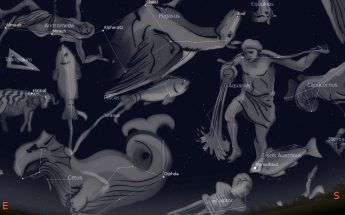This Week’s Sky at a Glance, 2024 Oct 12 – Oct 19
This Week’s Sky at a Glance, 2024 Oct 12 – Oct 19
With the Square of Pegasus appearing higher in the east after twilight, look under it (or outside the first base line of the diamond) for a circle of fainter stars. This asterism is the Circlet of Pisces which forms the head of one of the two fish that make up this zodiac constellation. The other fish head is to the left of Pegasus. Below left of the Circlet is the Vernal Equinox, the point where the Sun crosses the equator to mark the beginning of our spring season. At times it is still called the First Point of Aries, despite having moved well to the west of the zodiacal ram.
The two fish represent Aphrodite and her son Eros, who tied their ankles together with a cord before leaping into the sea and changing into fish to escape the fearsome monster Typhon. The star where the fishes’ tails meet is called Alrescha, which means “the cord.”
This Week in the Solar System
Saturday’s sunrise in Moncton is at 7:32 and sunset will occur at 6:37, giving 11 hours, 5 minutes of daylight (7:37 and 6:43 in Saint John). Next Saturday the Sun will rise at 7:42 and set at 6:24, giving 10 hours, 42 minutes of daylight (7:46 and 6:31 in Saint John).
The Moon is near Saturn on Monday evening and it is full and at perigee on Thursday, the closest full Moon of the year. Be prepared for extreme tides heading into next weekend. Venus shines brightly low in the southeast in the early evening, and it will be joined by comet C/2023 A3 Tsuchinshan-ATLAS to its right this weekend when it is closest to Earth. Over the week the comet will be moving to the upper left and by next weekend it will high above Venus. On Tuesday it will be within a binocular view of M5, a dense globular cluster in the constellation Serpens the Serpent. Saturn is at its highest and best for observing in late evening. Jupiter will be rising around 9:30 midweek, and next Friday telescope users might catch its Red Spot transiting at 10 pm. Reddish Mars can be seen rising in the middle of Gemini around 11:30.
Tune in to the Sunday Night Astronomy Show at 8 pm on the YouTube channel and Facebook page of Astronomy by the Bay.

